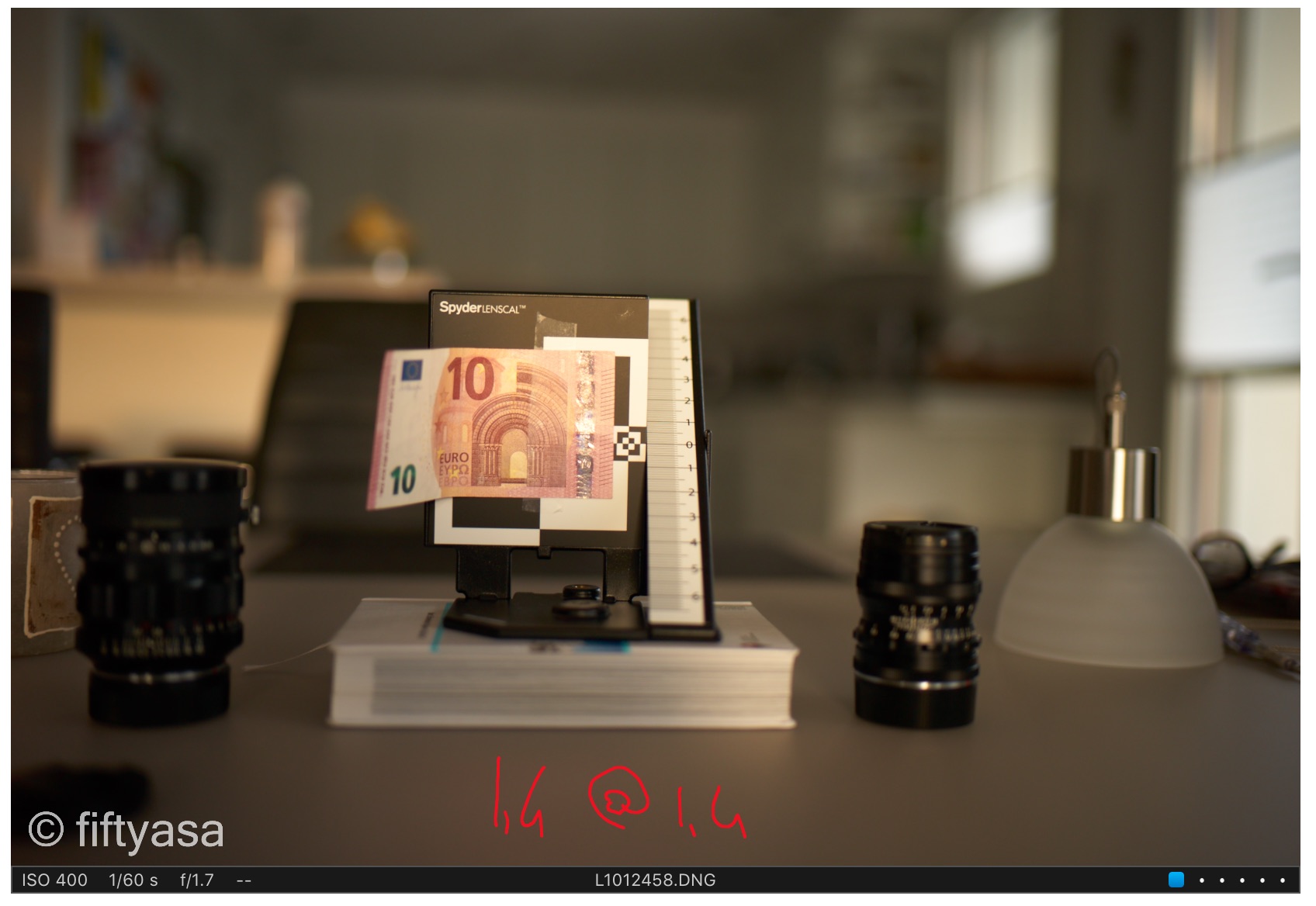Reviews: 8-2-2019: first draft. 10-2-2019: some tests repeated. New infinity test. New bokeh test.
This test compares the following lenses mounted on a Leica M9:
- Voigtländer Nokton 35mm f/1.2 Aspherical (version I)
- Zeiss Distagon T* 1.4/35 mm ZM
- Voigtländer Ultron 35mm f/1.7 Aspherical
Click on the images to see them in full resolution.
Central sharpness (short distance)
Central sharpness at short distance (around 70 cm) is measured with the following set-up:

The following pictures are 200% zoom of the centre. The ruler is used to check focus accuracy.
First test is at maximum aperture: the 1.4/35 shows the best sharpness and micro contrast. The Ultron comes in the second place but it is still very good.

At f/1.4, the 1.2/35 improves a bit, but the 1.4/35 is way better:

With the three lenses at f/1.7 (approximately), the 1.4/35 wins over the 1.7/35 which wins over the 1.2/35 (despite the latter being shot at lower ISO):

Update 10-2-2019: at constant ISO, the results are confirmed.
Finally all lenses at f/2. The 1.4/35 wins over the other two 35mm lenses, which deliver a very similar image quality (in terms of central sharpness).

Update 10-2-2019: the test repeated at constant ISO confirms that the Ultron and the Nokton deliver substantially the same central sharpness at f2.

Sharpness at infinity
[Update 10-2-2019]
The following landscape is used to test sharpness at infinity and 200%-zoom details of the centre and the corners are compared.

If you shoot stars at night, you might be interested in the performance at maximum aperture. The 1.7/35 is outstanding, matching the performance of the 1.4/35 (although not being at the same aperture). The 1.2/35 is not as sharp (although it is at f/1.2!) and if zoom is reduced to 100% on a 4k monitor the difference is negligible.

In the corners the 1.7/35 even outperforms the 1.4/35 (but again the latter is at 1/2 f-stop faster aperture):

With all lenses at f2, the 1.4/35 regains its supremacy, especially in the centre.
With all lenses at f8 (a more suitable aperture for landscape), the centre is undistinguishable: all are excellent! Feel free to guess who is who here:

In the corners the 1.2/35 falls a bit short but differences are hardly noticeable and only at 200% zoom on a 4k monitor. Ultron and Distagon are again very closed to each other:

Bokeh
The following images are a crop of the same image used for the close-up test above where some background is also visible.
First at maximum aperture. While the results of this particular shot are similar, the 1.2/35 delivers the creamiest bokeh, being also the fastest lens.

At the same aperture (f/2) the results are almost indistinguishable. Maybe the 1.2/35 (upper right) has a small edge in terms of smoothness.

In the next scene, I test again the three lenses at full aperture. All pictures show a smooth, creamy and pleasant bokeh with minor differences.

Zooming in, the differences between 1.2/35 and 1.4/35 are very small, but noticeable. The differences to the 1.7/35 are more evident (to a trained eye).

All lenses at f/2:

And a crop: again very similar results, with the 1.7/35 showing some oval highlights, whereas the faster lenses render the same highlights more rounded.

Update 10-2-2019. Some more bokeh shots. First one at max aperture. The 1.4/35 has the most controlled bokeh. The other two lenses show some swirl. The 1.2/35 has the creamiest blur.

All at f2. The 1.2/35 is much more controlled and very similar to the 1.4/35:

Here a 50% zoom of the image above. The 1.4/35 and 1.2/35 in this part of the picture are almost identical (same sequence as above):

Night bokeh, at 50% zoom. This series includes the 1.7/35 at min focus distance (1.7@1.7 min). The other pictures are at approx 0.7m. The 35/1.2 shows unfortunately onion rings.

And at f2:

Conclusions
The Zeiss Distagon T* 1.4/35 mm ZM is optically the best lens but also the most expensive.
The Voigtländer Nokton 35mm f/1.2 Aspherical (version I) is the most interesting lens: dreamy below f/2 but sharp and modern from f/2. Only issue to be aware of are the onion rings in the night bokeh. They are also visible on film. If you don’t like them and you often shoot at night, this is not the lens for you. If you shoot during day time, you won’t be affected. The bokeh of the Nokton 35mm f/1.2 in the daylight wonderful. I don’t have the Nokton 35mm f/1.2 Aspherical version II, but I don’t expect the version II to be substantially different.
The Voigtländer Ultron 35mm f/1.7 Aspherical is the best compromise in terms of image quality, speed, dimension, weight and price.

Very qualified and important presentation, thank you very much for this! It would have been very interessting to see additionally a comparison of the fall-off characteristics, maybe you want to add this?
Thanks for the message. Unfortunately I sold the Ultron and the Nokton. I normally add vignetting in my photos. I recall the Nokton had a strong fall off wide open. As one could imagine